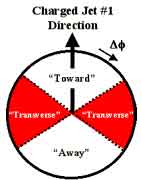 |
The "Transverse" Region and the "Underlying Event" |
|

|
|
The above figure shows the data on the average number of "transverse" region charged
particles compared with the QCD Monte-Carlo model predictions of HERWIG,
ISAJET, and PYTHIA.
|
 |

|
|
The above figure shows the data the average scalar PTsum of charged particles in the
"transverse" region compared with the QCD Monte-Carlo model predictions of HERWIG,
ISAJET, and PYTHIA.
|
 |

|
|
We expect the "transverse" region to be composed predominately from particles that arise from
the break-up of the beam particles and from initial-state radiation. For ISAJET this is clearly the case as can
be seen in the above figure where the predictions of ISAJET for the "transverse" region are divided into
three categories: charged particles that arise from the break-up of the beam particles
("beam-beam remnants"),
charged particles that arise from initial-state radiation, and charged particles that
result from the outgoing jets plus final-state radiation.
It is interesting to see that it is the "beam-beam remnant" component of ISAJET that is producing the
approximately constant plateau. The contributions from initial-state radiation and from the
outgoing hard scattering jets both increase as PTJ1 increases.
In fact, for ISAJET it is the sharp
rise in the initial-state radiation component that is causing the disagreement with the data for
PTJ1 greater than around 20 GeV/c.
Experimentally one cannot say where a given particle comes from. However,
we do know the origins of particles generated by the QCD Monte-Carlo models
and this figure shows the composition of the "transverse" region as modelled by ISAJET.
|
 |

|
 |

|
|
Since PYTHIA employs "color string fragmentation" it makes no sense to distinguish particles that
arise from initial-state radiation from those that arise from
final-state radiation, but one can
separate the "hard scattering component" from the
"beam-beam remnants". Also, for PYTHIA the
"beam-beam remnants" include contributions from multiple parton scattering.
The above figures compare the number of charged particles in the
"transverse" region with
the QCD Monte-Carlo model predictions of HERWIG and PYTHIA 6.115. Here the predictions are
divided into two categories: charged particles that arise from the break-up of the beam particles
("beam-beam remnants"), and charged particles that result from the outgoing jets plus initial
and final-state radiation ("hard scattering component"). As was the case with ISAJET the
"beam-beam remnants" form the approximately constant plateau and the "hard scattering"
component increase as PTJ1 increases.
|
 |

|
|
As can be seen in the above figure the "hard scattering" component of HERWIG and
PYTHIA does not rise nearly as fast as the "hard scattering" component of ISAJET.
There are two reasons why the "hard scattering" component of ISAJET is different from HERWIG
and PYTHIA. The first is due to different fragmentation schemes. ISAJET uses independent
fragmentation, which produces too many soft hadrons when partons begin to overlap. The second
difference arises from the way the QCD Monte-Carlo models produce parton showers. ISAJET uses a
leading-log picture in which the partons within the shower are ordered according to their invariant
mass. Kinematics requires that the invariant mass of daughter partons be less than the invariant
mass of the parent. HERWIG and PYTHIA modify the leading-log picture to include color
coherence effects which leads to angle ordering within the parton shower. Angle ordering
produces less high PT radiation within a parton shower which is what is seen the above figure.
|
 |

|
|
The "beam-beam remnant" contribution to the
"transverse" <Nchg> is different for each of the QCD
Monte-Carlo models. This can be seen in the above figure where we compare directly the "beam-beam
remnant" component from ISAJET, HERWIG, PYTHIA 6.115, and
PYTHIA with no multiple parton interactions. Since we are considering only charged particles
with PT > 0.5 GeV/c, the average number of charged particles in the "transverse"
region is related to the transverse momentum
distribution of the "beam-beam remnant" contributions. A steeper PT distribution means less
particles with PT > 0.5 GeV/c. PYTHIA uses multiple parton scattering to
enhance the "underlying event" and
we have included these contributions in the "beam-beam remnants". For PYTHIA the height of the
"underlying event" plateau can be adjusted by adjusting the amount of multiple parton scattering.
HERWIG and ISAJET do not include multiple parton scattering. For HERWIG and ISAJET the
height of the plateau can be adjusted by changing the PT distribution of the "beam-beam remnants".
|
 |
Click to see more about the PT distribution in the "transverse" region. |
 |
Click to see more about the tuning of PYTHIA to fit the "underlying event". |
 |
Click to return to the introduction. |
|
















